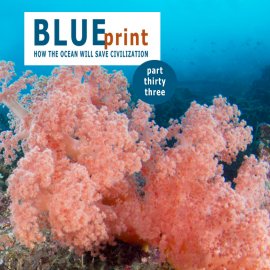The Ocean Genome, part 1
-
English
-
ListenPause
[intro music] Welcome to World Ocean Radio… I’m Peter Neill, Director of the World Ocean Observatory. One of the most revolutionary events of the modern era was the discovery of DNA, deoxyribonucleic acid, defined “as a molecule composed of two polynucleotide chains that coil around each other to form a double helix carrying genetic instructions for the development, functioning, growth and reproduction of all known organisms and many viruses. DNA and RNA, its single-stranded, mobile co-ribonucleic acid, along with proteins, lipids, and complex carbohydrates, represent the four major macromolecules that are essential for all known forms of life. This discovery has led to astonishing progress in our understanding of the chemistry of all species, of the origin and working of disease, and of intervention, processes, and treatments that have cured illness and prolonged life. It has also led to the concept of the genome, the complete cellular compendium of billions of DNA pairs, in humans some 3 billion base pairs contained in a single cell. The identification and interpretation of this genetic code has opened the idea of Nature to an encyclopedic catalogue of its parts and their interactions that provide explanations and guidance to researchers studying how life works, fails, survives, or dies. Understanding the genome has also informed the actuality of evolution of the species, the DNA combinations that have enabled certain species to adapt and thrive over time to meet the radically changing conditions of the surrounding environment, to respond successfully to exterior challenges, and to expand its tools for living that have accrued to the extent we presume to call civilization. From something so small and vulnerable comes an entity and organization so enormous, yet still so fragile, as adaptations on Earth, on land and sea, as knowledge accumulated for human survival. What do we do with what we know? DNA has triggered any number of technical, medical, and financial initiatives. GMOs, genetically modified organisms, for example, have had enormous impact on industrial agriculture, seeds for crop variants like corn that are more resistant to certain diseases with major increase in yield. In seafood, the introduction of growth hormones from a Pacific chinook into the genetic structure of an Atlantic salmon has proven to increase appetite and to bring fish to market size faster than other farmed salmon. There is also some evidence that such gene transfer can occur outside the lab, eDNA, loose in seawater for example, transfers a genetic characteristic outside normal reproduction, in one controversial case an “antifreeze” gene naturally passed from herring to smelt to help survival in extreme cold water. The financial implications are obvious, and research into eDNA in the ocean is growing in the form of seawater sampling data to be used to monitor and collect bio-informatics, stored and interpreted to monitor abundance and location of fish species, to inform regulators, protect over-catch, calculate quotas, and close certain areas to protect future population and conserve supply. The value to commercial enterprise is already revealed: the reduction of time and expense for comparison studies of environmental conditions for documentation required for offshore oil, gas, and mining; for port expansion and dredging; and for coastal development. Some government regulations approve or require eDNA analysis for environmental impact statements on which very lucrative opportunities are approved or denied. The ocean genome, then, is not just an abstraction without practical, possibly dangerous implications. As usual, commercial interests are out in front with efficiencies and advantages financed and in place for exploitation of resources newly accessed and technologies newly applied. An article in the August 2020 volume of Nature Sustainability, an academic journal, states that “of the 34 major animal phyla existing, only 12 are found on land, while the rest are found in the sea. It is estimated that some 2.2 million probably exist in the ocean, of which only 230,000 are confirmed…This number and diversity of marine life reaches monumental orders of magnitude…some 24-98% of marine species…remain undescribed.” What do we do with what we don’t know? It is clear that we don’t know a lot, and yet we are already hard at monetizing our ignorance to the advantage of corporate interest, private profit, and repeating the mistakes of the past by applying failed premises to the last great opportunity before us, for the benefit for all human kind, as vast and deep and dynamic as the ocean itself. We will discuss these issues, and more, in future editions of World Ocean Radio. [outro music]
This week on World Ocean Radio: part thirty-three of the multi-part BLUEprint series. This week, as part of our focus on new approaches and ideas to simplify our strategies for living sustainably on earth, we discuss RNA, DNA, the concept of the genome as an encyclopedic catalog for Nature as a way to provide guidance and explanations for how life works, and the various implications of eDNA on the ocean.

The "BLUEprint Series: How the Ocean Will Save Civilization" outlines a new and sustainable path forward, with the ocean leading the way.
About World Ocean Radio
Since 2009, a weekly 5-minute podcast covering a broad spectrum of ocean issues from science and education to advocacy and exemplary projects. World Ocean Radio, a project of the World Ocean Observatory, is available for syndicated use at no cost by college and community radio stations worldwide. Contact director@thew2o.net if you are interested in becoming an affiliate or know of a radio station that should be broadcasting these episodes each week.
- Login to post comments



